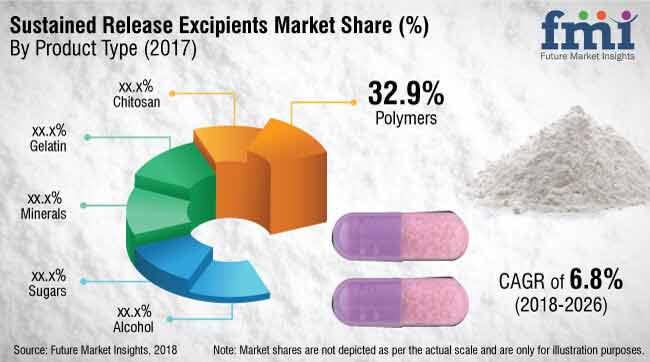The Global Sustained Release Excipients Industry is experiencing a significant surge, marked by a Compound Annual Growth Rate (CAGR) of 6.8% from 2018 to 2026. The market dynamics, influenced by a range of factors, reveal a landscape dominated by local manufacturers engaging in fierce pricing competition.
In a market characterized by fragmentation, the battle for pricing supremacy has been a double-edged sword, impacting profitability for many businesses. However, a noteworthy shift is underway, propelled by a growing awareness of sustained release excipients on a global scale. The increased recognition is partly attributed to concerns over the test specificity and sensitivity associated with sustained-release excipients produced by local companies.
Leading the charge in this transformative phase are industry giants such as BASF Corporation, Ashland Global Holdings Inc., and The Dow Chemical Company. Together, these companies command an impressive 42.8% revenue share in the global sustained release excipients market, demonstrating their dominance and strategic positioning.
.Request a sample
https://www.futuremarketinsights.com/reports/sample/rep-gb-7580
Abusive Consumption of Drugs (Pain Killers) Increasing the Incidence of Chronic Diseases Across North America: Sustained release formulations are gaining popularity as they help in maintaining patient safety through a reduced number of medicine dosages, but have increased drug efficacy. From a market point of view, reduced doses improve treatment compliance, which could help higher unit sales and so their revenues. Furthermore, from the patient’s point of view, better therapeutic outcomes are expected due to improved drug tolerance and efficacy leading to lower switching costs and greater physician loyalty.
Increment of Diseases Across the Globe: The prevalence of chronic and acute diseases is increasing across the globe. For the treatment of these diseases, doctors prescribe medicines. Medicines usually contain excipients along with active pharmaceutical ingredients. A huge demand for medicines is witnessed because of the increasing prevalence of chronic diseases. They are high in demand in the Asia Pacific because of the huge volume in this region. Sustained excipients release the drug slowly to reach the target site. An excipient can be used in many ways. Due to this fact, it is in great demand. Sustained release excipients reduce the indirect cost associated with conventional excipients.
Vertical Integration of Sustained Release Excipients Service Providers: Sustained release excipients service providers are offering their services through retail channels.
Increasing innovative collaborative research opportunities in pediatric formulations are being pushed through the evolution of new regulations, additional funding opportunities, and increased public-private partnerships.
Request a TOC@ https://www.futuremarketinsights.com/toc/rep-gb-7580
This has been focused on the development of excipients used in all kinds of excipients such as oral solid dosage formulations and liquid pediatric formulations, which are flexible, dispersible, and multi-functional. Furthermore, continued prioritization of unmet medical needs in pediatrics is expected to drive demand for these excipients and oral formulations in the forthcoming years.
Growing Impact of Drug Abuse on Public Health: Substance abuse has a high impact on the health of individuals and their families. Prolonged drug and alcohol abuse may lead to mental illness and chronic diseases, such as diabetes and heart disease, cancer, which in turn, can create a high economic burden on society. To curb this economic burden caused by drug abuse, governments are focusing on prevention, and early intervention strategies are expected to drive demand for drugs of abuse. For instance, according to the Centers for Disease Control and Prevention (CDC), nearly 10 million individuals aged 55 and above were reported to seek treatment for cancer across the globe. in 2014. Moreover, it is estimated that nearly US$ 600 Bn is spent on addressing the impact caused by substance abuse each year in the U.S.
Competitive Landscape: The competition section of the sustained release excipients market features profiles of key players operating in the industry based on their market shares, differential strategies, product offerings, marketing approach, and company dashboard. Examples of some of the key players featured in this report include FMC Corporation, Ashland Global Holdings, BASF Corporation, The Dow Chemical Company, Roquette Freres S.A. Colorcon Inc., and Croda International Inc. The key manufacturers of sustained-release excipients are focusing on novel marketing strategies to increase product penetration. The companies offering point-of-care sustained release excipients are concentrating on price floor strategies.
Ask An expert here https://www.futuremarketinsights.com/askus/rep-gb-7580
These companies are offering their products with lucrative discounts. Conventional distribution channels, such as retail pharmacies, drug stores, supermarkets, and hypermarkets are expected to be the key target channels for local manufacturers.
Definition: Sustained release excipients are one of the types of excipients that are added to the drug along with active pharmaceutical ingredients of medication. Sustained release excipients are pharmacologically non-active ingredients of the drug formulation.
About the Report: The report offers a comprehensive evaluation of the business opportunities prevailing in the sustained release excipients market along with insights on the sustained release excipients consumption trend, disease incidences, and awareness level for sustained release excipients and sustained release excipients market competition. The report elaborates on the macroeconomic factors influencing the dynamics of the sustained release excipients market and its futuristic potential.
Research Methodology: The sustained-release excipients market has been estimated based on a supply-demand approach. The market was first calculated based on allergy test volume conducted in different regions/countries. The test volume was estimated based on the incidence rate of various types of allergies in the top 20 countries globally. Other qualitative factors analyzed during test volume estimation include awareness level for point care sustained release excipients, the recurrence rate of allergy reaction, and others. This information is further validated with rigorous primary research (including interviews, surveys, in-person interactions, and viewpoints of seasoned analysts) and secondary research (including verified paid sources, authentic trade journals, and resourceful databases). The research study on the sustained release excipients market also includes top trends and macro as well as microeconomic factors shaping the sustained release excipients market. With this approach, the report on the sustained release excipients market anticipates the industry attractiveness of every major segment in the sustained release excipients market over the forecast period.
Segmentation: The report offers a comprehensive taxonomy of the sustained release excipients market based on product type, end-user, route of administration route, and region. The sustained-release excipients are sold for various types of test samples, such as blood, skin, etc. These sustained-release excipients are used by pharmaceutical companies, biopharmaceutical companies, and neutraceutical companies, and for various types of sustained-release excipients, such as food allergies, drug allergies, latex allergies, and other types of allergies. End-use segments in the sustained release excipients market which are a part of this sustained release excipients market report include pharmaceutical companies, biopharmaceutical companies, and other end users, such as nutraceutical manufacturers and contract manufacturing organizations.
The sustained release excipients market has been analyzed across regions of North America, Latin America, Europe, CIS & Russia, Asia Pacific, and MEA.
Author
Sabyasachi Ghosh (Associate Vice President at Future Market Insights, Inc.) holds over 12 years of experience in the Healthcare, Medical Devices, and Pharmaceutical industries. His curious and analytical nature helped him shape his career as a researcher.
Identifying key challenges clients face and devising robust, hypothesis-based solutions to empower them with strategic decision-making capabilities come naturally to him. His primary expertise lies in Market Entry and Expansion Strategy, Feasibility Studies, Competitive Intelligence, and Strategic Transformation.
Holding a degree in Microbiology, Sabyasachi has authored numerous publications and has been cited in journals, including The Journal of mHealth, ITN Online, and Spinal Surgery News.
About Future Market Insights (FMI)
Future Market Insights, Inc. (ESOMAR certified, recipient of the Stevie Award, and a member of the Greater New York Chamber of Commerce) offers profound insights into the driving factors that are boosting demand in the market. FMI stands as the leading global provider of market intelligence, advisory services, consulting, and events for the Packaging, Food and Beverage, Consumer Technology, Healthcare, Industrial, and Chemicals markets. With a team of over 5,000 analysts worldwide, FMI provides global, regional, and local expertise on diverse domains and industry trends across more than 110 countries.
Contact Us:
Future Market Insights Inc.
Christiana Corporate, 200 Continental Drive,
Suite 401, Newark, Delaware – 19713, USA
T: +1-845-579-5705
For Sales Enquiries: sales@futuremarketinsights.com
Website: https://www.futuremarketinsights.com
LinkedIn| Twitter| Blogs | YouTube





